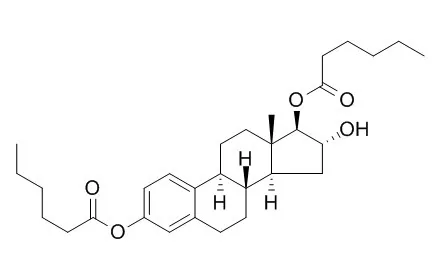METHODS AND RESULTS:
Twelve female volunteers from Berlin and 9 from Stockholm, all using a contraceptive pill (30 micrograms ethinyl estradiol and 150 micrograms levonorgestrel), received an intramuscular injection of estriol (E3; 1 mg in oil) on day 5 of withdrawal bleeding. Blood samples were collected at increasing time intervals during 4 weeks. Three months later, on day 5 of their withdrawal bleeding, 6 women were given intramuscularly (in oil) estriol 3,17-dipropionate (E3-prop) and 15 women Estriol 3,17-dihexanoate (E3-hex). The doses were equivalent to 5 mg of estriol, i.e. 6.94 and 8.90 mg, respectively. Blood samples were collected during a period of 9 weeks. Estriol was analyzed by radioimmunoassay in all plasma samples. The average half-life of E3 ranged from 1.5 to 5.3 h after the administration of E3. It was 12.7 h and between 187 and 221 h after the administration of estriol 3,17-dipropionate and Estriol 3,17-dihexanoate, respectively. The average areas under the curve (in nmol.l-1.h) of E3 were between 82.5 and 161 after the administration of estriol 3,17-dipropionate or Estriol 3,17-dihexanoate, and between 27.1 and 37.9 when E3 had been given. As E3 was administered in a 5-fold lower dose than the esters, the areas under curve appeared to be comparable.
CONCLUSIONS:
Thus, the total exposure to E3 seemed to be almost independent of the type of E3 derivatization, while the time and intensity of exposure were very different. |






 Cell. 2018 Jan 11;172(1-2):249-261.e12. doi: 10.1016/j.cell.2017.12.019.IF=36.216(2019)
Cell. 2018 Jan 11;172(1-2):249-261.e12. doi: 10.1016/j.cell.2017.12.019.IF=36.216(2019) Cell Metab. 2020 Mar 3;31(3):534-548.e5. doi: 10.1016/j.cmet.2020.01.002.IF=22.415(2019)
Cell Metab. 2020 Mar 3;31(3):534-548.e5. doi: 10.1016/j.cmet.2020.01.002.IF=22.415(2019) Mol Cell. 2017 Nov 16;68(4):673-685.e6. doi: 10.1016/j.molcel.2017.10.022.IF=14.548(2019)
Mol Cell. 2017 Nov 16;68(4):673-685.e6. doi: 10.1016/j.molcel.2017.10.022.IF=14.548(2019)